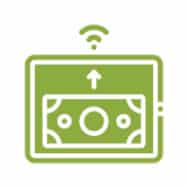Financial Literacy for Kids
These are prime years for teaching the basics of money management. Your kids are gaining a more in-depth understanding of how money works and are still interested in learning from you. During this age range, your kids should be ready for a number of mature financial steps.

Key Money Basics for Ages 8-10
- Performing small jobs to learn the value of earning money.
- Saving for longer-term goals.
- Opening a bank account and learning the basics of online banking.
- Assuming greater financial responsibility with a larger allowance.
- Introducing digital finances through a chore or allowance app.
- Using money- and number-based online games, apps, and educational resources to expand digital financial learning.
EXPLORE TOPICS

Teach Through More Advanced Play
Show Tips
- Play board games together like ‘Monopoly’ and ‘The Game of Life.’
- Allow your kids to access age-appropriate online games that focus on money and money management.
- Have your child count and roll coins from their savings jar or piggy bank into paper bank wrappers. Let them exchange the coin rolls at the bank for dollar bills to save and spend.
- Challenge your kids to calculate change using coins and dollar bills.

Prepare for Peer Pressure
Around age 8 is when peer pressure begins to influence some children. It’s important to set good examples, and to find an approach that recognizes your kids’ viewpoints, while still supporting your family values.
Show Tips
- Talk about branding and how it can influence spending decisions.
- Focus on fostering self-esteem, based on your kid’s special talents and personal qualities, not what they wear, buy, or use.
- Listen and discuss your kids’ requests openly and with understanding. You can’t win every battle, nor do you want to turn every request into one, so try to compromise some of the time.
- Always explain how you reach your decisions and how they relate to what’s important to your family, e.g., saving for family vacations, college, shared activities, or giving to others.
- When you have to say “No,” focus on how your children are special in non-material ways, such as sporting or musical talents, and how you love them for their kindness, determination, intelligence, and more.

Give Your Kids a Little Independence
As your kids gain a greater understanding of how money works, they’re ready for more responsibilities and independent purchases. Give them guidance on sensible spending, planning ahead and how to learn from mistakes.
Show Tips
- Increase your kids’ allowance annually and include greater purchase responsibilities, such as paying for toys, snacks on outings, and refreshments at the movies.
- Your kids are growing up, but they still want, need, and value your input.
- Discuss the role and purpose of marketing and branding – to encourage spending.
- Give guidance on making wise purchase decisions based upon price, value, quality, needs versus wants, what you can afford, and family values.
- Help them monitor spending and purchases, using a simple budget as needed.
- Provide guidance, but as they get older, give your children more free rein in making spending decisions.
- One of the best ways to teach budgeting is to avoid bailouts.
- If your kids run out of money to buy snacks, encourage them to plan ahead and pack snacks to take with them on activities.
- If they need more money to buy something, allow them to work around the house to earn additional money.
- Encourage free activities when allowance money is spent too quickly.
- Consider authorizing a prepaid debit card for purchases. These can afford you greater online oversight of your kid’s spending habits.

Teach Wise Money Management
Your kids are ready to assume greater purchase responsibilities, which means a bigger allowance. Make sure the amount is modest, yet large enough to accommodate learning, expanded decisions and choices. It should still be paid consistently on a weekly basis.
Show Tips
- Some parents tie an allowance to chores. This is a personal decision. The most important objective is tying the allowance to financial responsibility and agreed-upon purchases.
- There’s no precise allowance amount. The best number is one that recognizes:
- Realistic expectations about what things cost.
- Consideration of how much allowance your child is ready to manage.
- A progression that gradually prepares your kids for real life and an attainable budget that they can afford in the future.
- Your individual family values and beliefs about money and more.
- The amount of allowance you choose should be adequate to cover:
- Basic purchase needs for which your kids are responsible.
- A small amount for discretionary spending.
- A small amount to be set aside for savings and longer-term goals.
- Work together to develop a simple budget that helps guide your children’s spending and saving choices.
- You need to stand firm and don’t bail them out if your kids overspend and run out of money. Reinforce the need to stick to their budget.
- If something is really important and their allowance isn’t enough, you can encourage small jobs around the home to earn extra cash.
- Review their allowance yearly (perhaps around your child’s birthday). Annual increases are recommended, in line with increased financial and purchase responsibilities.
- Consider using an online allowance app to introduce digital finances, including setting savings goals, budgeting, and tracking success.

Promote the Value of Work & Wages with Simple Jobs
It’s time to teach the value of earning a dollar. Simple experiences like setting up a lemonade stand go a long way towards developing a strong work ethic. Encourage your kids to be creative and think of jobs to earn a few dollars.
Show Tips
- This is a great age to advocate service jobs at or near home. Examples include being a kitchen or mother’s helper, raking leaves, pulling weeds, washing cars, pet sitting, etc.
- Working helps kids to develop a stronger sense of personal responsibility.
- Both parents and kids can easily track chores and money earned using a chore/allowance app.
- Money earned can cover allowance shortfalls if your kids go over budget and run through their money too quickly. If you don’t have it, earn it.
- Always recommend that some amount of earnings be allocated to saving for special purchases, longer-term savings, and giving.

Encourage Short-term Savings
Your kids are ready to start thinking longer-term. Encourage them to set aside cash toward future goals, both big and small. Savings should be rewarding, so let them enjoy the fruits of their efforts, while also committing some savings to the future.
Show Tips
- Help your kids to begin saving for future purchases such as birthday gifts for family members or extra spending money for family vacations.
- Online allowance and saving apps make it easy to set one or two big savings goals a year and track success. You could even consider instituting a savings matching program as an extra incentive.
- Also encourage long-term savings for college. We strongly recommend this by age 10, even if you plan to pay for college. Saving for college teaches the importance of planning and saving for the future, and defines a goal of academic achievement.
- Long-term savings are ideally being deposited into your child’s bank account by age 10.
- Some parents set specific saving goals such as 10% to 30% of your children’s allowance. The right amount for you depends upon family goals and financial abilities. It also depends upon your participation in monitoring saving achievements.

Establish a Custodial Bank Account
By age 10, your children should be ready for the next step toward financial independence: opening a bank account. This can be both exciting and scary for kids, so be sure to talk in advance to prepare them.
Show Tips
- Do your research in advance. It’s important to find a kid friendly bank. Talk to the bank before you take your kids. Ask about maintenance fees and charges for your kids to visit branch locations to make deposits and withdrawals. Also ask about educational services, including printed materials and online banking features.
- Together, review their account online on a regular basis. For security reasons, we recommend that you retain control of the login and password info.
- Opening an account can be disconcerting if your kids don’t understand that they can get back the dollars and coins they’ve saved, and that they’ll get different dollars and coins when they go back to make a withdrawal.
- Be sure to discuss these concerns before visiting the bank together.
- If your children have dollars or coins of sentimental value (e.g., crisp bills from birthday gifts), keep those at home until your kids are ready to part with them.
- Set objectives for how the bank account will be used, such as setting aside a certain amount of allowance money and any earned income toward big purchase goals, plus some amount for long-term term college savings.
- Encourage trips to the bank, but still keep weekly spending money at home. If spending, saving, and giving jars work for your kids, continue to use them at home, with the bank facilitating longer-term savings.
- When your kids make withdrawals, be sure to discuss them in advance, making sure some amount of savings remains committed to the future, while still enjoying some of the fruits of saving today.

Demonstrate Different Ways of Giving
This is a great age to involve your kids in giving to worthy causes. They’re old enough to appreciate both the need and how they can help. Giving can be financial or of time and talent. It should reflect and reinforce the family values you want to instill.
Show Tips
- The most important lesson in giving is direct involvement. This means having experiences with organizations and causes you support, or participating in school-based charitable efforts.
- If you believe in financial giving, encourage your kids to give a portion of their allowance and earnings to worthwhile causes.
- Try to ensure they make the contribution in person so that they can see the smile and hear the thanks that make their gifts meaningful.
- Some parents establish separate jars at this age, either actual or virtual, for spending, saving, and giving. Consider adding a ‘jar’ to save for giving if this aligns with your family values.

Empower Sensible Expectations for Life
Many kids are now focused on lifestyle choices such as clothing, activities, technology, and vacations. They’re also listening to what you say about other people’s choices. Be mindful of the impressions, judgments, and expectations you’re creating.
Show Tips
- Think about what you say when you talk about something you want or must have, and consider what your kids are learning from you.
- Refrain from negative comments about others, such as how someone dresses or their life choices. Make sure that your actions and comments support your values.
- Always remember that the experiences your kids enjoy today become their baseline of expectations going forward. Focus on creating realistic financial expectations.

Teach Financial Responsibility by Example
These are formative years. You remain the most important example in your kids’ lives, and they still want to learn from you. The examples you set now will determine how your kids will ultimately manage their own money. Act wisely.
Show Tips
- Be sure that you’re setting a good example by thinking about the following:
- Your own money personality and how you manage your money.
- How you interact with your children, family members, and others regarding money topics.
- What you say about work.
- However you react and relate to money, try to avoid extremes. Model sensible spending patterns that are neither too restrictive nor too free.
If you are financially affluent, consider the wealth effect and the benchmarks your lifestyle establishes. Make sure that the privileges your kids enjoy are ones that they can expect to sustain later in life.

Introducing Digital Learning
Now that they’re better able to conceptualize money and cashless transactions, your kids’ natural curiosity and enthusiasm for learning should extend to learning about digital finances and virtual money transactions.
Show Tips
- Consider switching to a digital allowance and/ or chore app. These digital banking apps replace the piggy bank or coin jar, offering colorful online visualizations of saving and spending.
- Busy parents can auto-deposit allowance, set spending limits, connect chores, and block certain transactions.
- Kids can create a basic budget, set savings goals, and track progress.
- Many digital resources come with the ability to link directly to your kid’s bank account to facilitate the transfer of savings as they accumulate.
- Some apps also include a prepaid debit card option for your kids. This may sound scary for parents. However, you gain broad oversight of your child’s spending habits, typically with real-time alerts each time your kid completes a transaction, plus the ability to turn the card off if necessary e.g., the card gets lost.
- Ensure your kid’s new bank account includes online functionality. Introduce the basics of online banking, such as viewing the account and monitoring the balance.
- Online games and apps continue to support financial learning (make sure in-game purchasing is turned off).
- Explain the difference between digital payment methods and the basics of how they work:
- Debit cards and phone payments remove funds directly from your bank account. The funds must be available for these payment methods to work.
- Credit cards act as short-term loans that must be repaid each month. There’s a limit to how much you can spend and each month you’ll get a bill that must be paid, so you must set aside money for that purpose.
- Discuss how money might seem ‘invisible’ but it’s real money that you’ve earned, that there’s a finite amount, and that just like coins and dollar bills, it can only be spent once.






